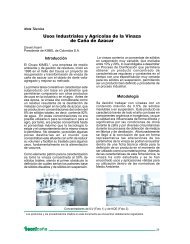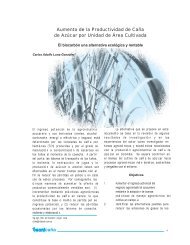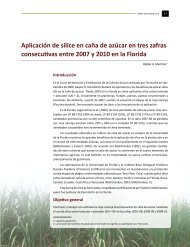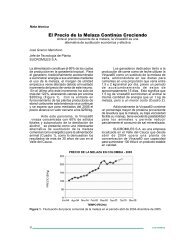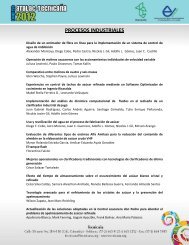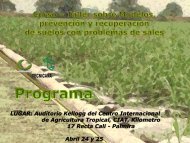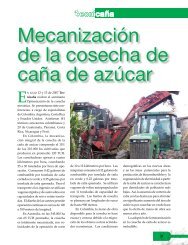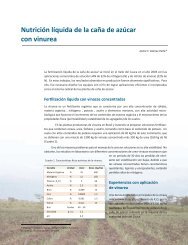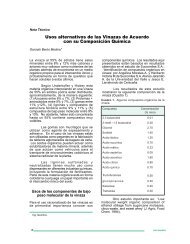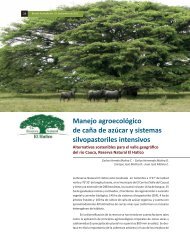Usos de la tierra diatomea - Tecnicaña
Usos de la tierra diatomea - Tecnicaña
Usos de la tierra diatomea - Tecnicaña
You also want an ePaper? Increase the reach of your titles
YUMPU automatically turns print PDFs into web optimized ePapers that Google loves.
www.tecnicana.org 31<br />
<strong>Usos</strong> <strong>de</strong> <strong>la</strong> <strong>tierra</strong> <strong>diatomea</strong><br />
Luis Baglione*<br />
Las diatomitas son esqueletos <strong>de</strong> algas unicelu<strong>la</strong>res microscópicas, <strong>de</strong><br />
composición silícea, <strong>de</strong>positadas en lechos acuíferos que al secarse se fosilizaron<br />
y se comprimieron formando roca.<br />
Existen varios tipos <strong>de</strong> <strong>diatomea</strong>s. La Au<strong>la</strong>coseira granu<strong>la</strong>ta, rica en<br />
silicio (42%), pertenece a <strong>la</strong>s <strong>diatomea</strong>s <strong>de</strong> agua dulce. Es navícu<strong>la</strong> (en forma<br />
<strong>de</strong> canoa) e incluye individuos con extremos redondos y válvu<strong>la</strong>s <strong>la</strong>nceo<strong>la</strong>das,<br />
estriadas transversalmente en <strong>la</strong> zona media en sentido opuesto a los polos.<br />
El alto contenido <strong>de</strong> sílice favorece su uso en <strong>la</strong>s p<strong>la</strong>ntas, ya que este elemento<br />
beneficia los cultivos: les da resistencia ante distintos factores ambientales<br />
bióticos y abióticos y los protege <strong>de</strong> ellos. A<strong>de</strong>más <strong>de</strong> silicio, contiene micronutrientes<br />
(Cuadro 1) que facilitan <strong>la</strong> capacidad <strong>de</strong> intercambio catiónico y <strong>la</strong><br />
absorción <strong>de</strong> nutrientes por <strong>la</strong> p<strong>la</strong>nta.<br />
Los macronutrientes presentes en el suelo (nitrógeno, fósforo y potasio,<br />
entre otros) son importantes para el <strong>de</strong>sarrollo y <strong>la</strong> producción <strong>de</strong> <strong>la</strong>s p<strong>la</strong>ntas;<br />
no obstante, su acción es limitada cuando <strong>la</strong> disponibilidad <strong>de</strong> micronutrientes<br />
en el suelo no es a<strong>de</strong>cuada. La <strong>tierra</strong> <strong>diatomea</strong>, en mezc<strong>la</strong> con fertilizantes<br />
químicos u orgánicos, suple los micronutrientes que <strong>la</strong> p<strong>la</strong>nta requiere para<br />
su <strong>de</strong>sarrollo. A<strong>de</strong>más, por ser un producto natural, ayuda a conservar <strong>la</strong><br />
‘salud’ <strong>de</strong>l suelo.<br />
Cuadro 1. Composición mineral <strong>de</strong> <strong>tierra</strong> <strong>diatomea</strong>.<br />
Elemento Porcentaje Elemento Porcentaje<br />
Potasio 0.067 Zinc 0.004<br />
Calcio 0.12 Níquel 0.0005<br />
Magnesio 0.019 Al 2<br />
O 3<br />
8.75<br />
Fosforo 0.02 SiO 2<br />
90.07<br />
Azufre 0.042 K 2<br />
O 0.08<br />
Cobre 0.0019 Cao 0.168<br />
Hierro 0.5 MgO 0.032<br />
Sodio 0.067 P 2<br />
O 5<br />
0.05<br />
* Director Agrofix, empresa <strong>de</strong>l grupo Eztra<strong>de</strong> SAS. ventas@ez12tra<strong>de</strong>.com
32 Revista <strong>Tecnicaña</strong> No. 27, Septiembre <strong>de</strong> 2011<br />
Efectos benéficos <strong>de</strong>l<br />
silicio en <strong>la</strong>s p<strong>la</strong>ntas<br />
En condiciones <strong>de</strong> campo, el silicio<br />
es un elemento <strong>de</strong> gran importancia<br />
que estimu<strong>la</strong> el crecimiento <strong>de</strong> <strong>la</strong><br />
p<strong>la</strong>nta –entendido el crecimiento<br />
como <strong>la</strong> acumu<strong>la</strong>ción irreversible <strong>de</strong><br />
materia seca asociada con procesos<br />
<strong>de</strong> elongación y crecimiento celu<strong>la</strong>r–<br />
y aumenta <strong>la</strong> disponibilidad <strong>de</strong> elementos<br />
esenciales al contrarrestar<br />
el antagonismo generado en suelos<br />
con alta saturación <strong>de</strong> aluminio y<br />
hierro. En Colombia este elemento<br />
ha sido utilizado para prevenir los<br />
daños por p<strong>la</strong>gas y enfermeda<strong>de</strong>s<br />
en cultivos <strong>de</strong> arroz, caña <strong>de</strong> azúcar,<br />
papa y fresa. Algunos beneficios<br />
<strong>de</strong> <strong>la</strong> aplicación <strong>de</strong> silicio son los<br />
siguientes:<br />
• Incrementa <strong>la</strong> productividad y <strong>la</strong><br />
calidad <strong>de</strong> <strong>la</strong>s cosechas agríco<strong>la</strong>s.<br />
• Restaura el suelo <strong>de</strong> <strong>la</strong> <strong>de</strong>gradación<br />
e incrementa su nivel <strong>de</strong> fertilidad<br />
para <strong>la</strong> producción agríco<strong>la</strong>.<br />
• Incrementa <strong>la</strong> resistencia <strong>de</strong>l<br />
suelo contra <strong>la</strong> erosión <strong>de</strong>l viento<br />
y el agua, y a <strong>la</strong>s sequías.<br />
• Neutraliza <strong>la</strong> toxicidad <strong>de</strong>l aluminio<br />
(Al) en suelos ácidos.<br />
• Tiene acción sinérgica con calcio<br />
(Ca) y magnesio (Mg).<br />
• Reduce <strong>la</strong> lixiviación <strong>de</strong> fósforo<br />
(P), nitrógeno (N) y potasio (K) en<br />
<strong>la</strong>s áreas <strong>de</strong> cultivo agríco<strong>la</strong>.<br />
• Aumenta <strong>la</strong> resistencia <strong>de</strong> <strong>la</strong><br />
p<strong>la</strong>nta a p<strong>la</strong>gas y enfermeda<strong>de</strong>s.<br />
• Protege <strong>la</strong>s p<strong>la</strong>ntas contra el ataque<br />
<strong>de</strong> enfermeda<strong>de</strong>s, hongos e<br />
insectos.<br />
• Mejora el empleo <strong>de</strong> biosólidos.<br />
• Mejora <strong>la</strong> absorción <strong>de</strong> fósforo e<br />
incrementa <strong>la</strong> eficiencia <strong>de</strong> <strong>la</strong> roca<br />
fosfórica.<br />
• Restaura áreas contaminadas por<br />
metales pesados e hidrocarburos.<br />
• Fortalece el po<strong>de</strong>r oxidante en <strong>la</strong>s<br />
raíces <strong>de</strong>l arroz.<br />
• Promueve una mayor tasa <strong>de</strong><br />
fotosíntesis.<br />
• Disminuye <strong>la</strong> excesiva absorción <strong>de</strong><br />
hierro y manganeso.<br />
Dosis y forma<br />
<strong>de</strong> aplicación<br />
En el Cuadro 2 se incluyen <strong>la</strong>s dosis<br />
recomendadas y <strong>la</strong>s formas <strong>de</strong> aplicación<br />
<strong>de</strong> <strong>tierra</strong> <strong>diatomea</strong>.<br />
Cuadro 2. Dosis recomendada <strong>de</strong> Tierra Diatomea, según <strong>la</strong> forma <strong>de</strong> aplicación.<br />
Dosis aplicación foliar* (1%)<br />
Aplicación por espolvoreo<br />
en suelo con pH neutro<br />
Agua Diatomea<br />
kg Aditivo ** Área Diatomea<br />
kg<br />
(litros)<br />
(g)<br />
(m 2 )<br />
(g)<br />
1 10 0.2 1 0.6 0.0006<br />
5 50 1 10 6 0.006<br />
10 100 2 100 60 0.06<br />
50 500 0.5 10 500 300 0.03<br />
100 1000 1 20 1000 600 0.6<br />
150 1500 1.5 30 2000 1200 1.2<br />
200 2000 2 40 3000 1800 1.8<br />
250 2500 2.5 50 4000 2400 2.4<br />
300 3000 3 60 5000 3000 3.0<br />
350 3500 3.5 70 6000 3600 3.6<br />
400 4000 4 80 7000 4200 4.2<br />
450 4500 4.5 90 8000 4800 4.8<br />
500 5000 5 100 9000 5400 5.4<br />
10,000 6000 6.0<br />
Dosis aplicación en suelo (2%)<br />
Aplicación por espolvoreo<br />
en suelo ácido<br />
Agua (gr) kg Cucharadas<br />
Área gr kg<br />
(litros)<br />
(no.)<br />
(m 2 )<br />
1 20 2 1 0.8 0.0008<br />
5 200 20 10 8 0.008<br />
10 200 0,2 100 80 0.08<br />
50 1000 1 500 400 0.4<br />
100 2000 2 1000 800 0.8<br />
150 3000 3 2000 1600 1.6<br />
200 4000 4 3000 2400 2.4<br />
250 5000 5 4000 3200 3.2<br />
300 6000 6 5000 4000 4<br />
350 7000 7 6000 4800 4.8<br />
400 8000 8 7000 5600 5.6<br />
450 9000 9 8000 6400 6.4<br />
500 10000 10 9000 7200 7.2<br />
10,000 8000 8<br />
*Pue<strong>de</strong> variar según estudio <strong>de</strong>l suelo.


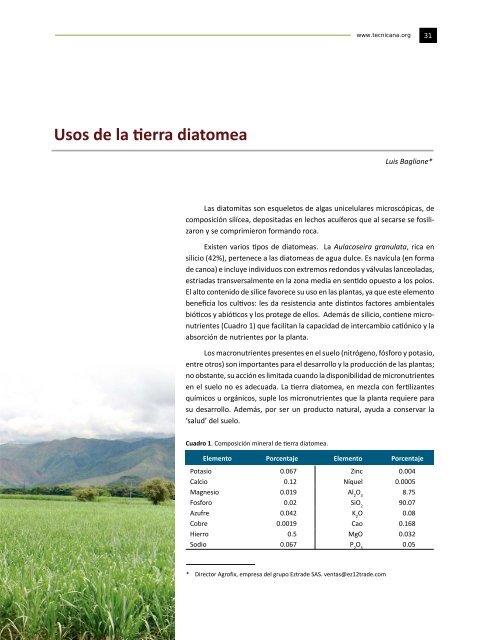
![Texto completo [PDF - 5300 kb] - Tecnicaña](https://img.yumpu.com/50658533/1/190x248/texto-completo-pdf-5300-kb-tecnicana.jpg?quality=85)
